- What is Godetia?
- Types and Varieties of Godetia
- How to Grow Godetia from Seeds
- Benefits of Growing Godetia from Seeds
- 1. Cost-effective
- 2. Wide variety of options
- 3. Control over the growing process
- 4. Satisfaction of nurturing plants from the beginning
- 5. Potential for seed saving
- Types of Godetia
- 1. Godetia grandiflora
- 2. Godetia amoena
- 3. Godetia bottae
- 4. Godetia pinifolia
- 5. Godetia quadrivulnera
- 6. Godetia johannessenii
- 7. Godetia rothrockii
- Single Godetia
- Characteristics of Single Godetia
- Growing Single Godetia from Seeds
- Popular Varieties of Single Godetia
- Double Godetia
- Varieties of Godetia
- 1. Godetia grandiflora
- 2. Godetia amoena
- 3. Godetia picta
- 4. Godetia quadrivulnera
- 5. Godetia bottae
- 6. Godetia amabilis
- Grace Godetia
- Characteristics
- Growing Grace Godetia
- Uses
- Conclusion
- Satin Godetia
- Characteristics
- Growing Satin Godetia
- Uses
- Conclusion
- Dwarf Godetia
- Characteristics
- Growing from Seeds
- Uses
- Tall Godetia
- Growth and Characteristics
- Planting and Care
- Uses
- Conclusion
- Questions and Answers:
- What is godetia?
- How do I grow godetia from seeds?
- What are the different types of godetia?
- Can I grow godetia in containers?
- How long does it take for godetia to bloom?
- Where can I buy godetia seeds?
- Videos: Godetia, Yarrow, and Snapdragon Flower Arrangements from the Cut Flower Garden
If you’re looking for a beautiful and easy-to-grow flower for your garden, look no further than Godetia. Also known as Clarkia, Godetia is a popular annual flower that can add vibrant colors to any garden bed or container. In this article, we will explore how to grow Godetia from seeds, the different types of Godetia, and the various varieties you can choose from.
Godetia seeds are readily available and can be easily grown from scratch. You can either start the seeds indoors about 6-8 weeks before the last frost date or sow them directly into the garden once the soil has warmed up in the spring. Godetia prefers full sun but can tolerate some light shade. The seeds should be sown in well-drained soil that has been enriched with compost. Keep the soil slightly moist until the seeds germinate, which usually takes around 7-14 days.
There are several types of Godetia available, including compact varieties that are perfect for containers and hanging baskets, as well as taller varieties that add height and texture to flower beds. Some types of Godetia have ruffled petals, while others have smooth, satiny blooms. The flowers come in a range of colors, including pinks, purples, whites, and bi-colors. With so many types to choose from, you can easily find one that suits your garden’s aesthetic.
Here are a few popular varieties of Godetia that you might consider for your garden: ‘Grace Mix’ is a compact variety with double flowers in shades of pink, lavender, and white. ‘Dwarf Mix’ is another compact type that produces double flowers in various colors. ‘Farewell to Spring’ is a taller variety that boasts large, showy flowers in shades of pink, purple, and white. ‘Antique Shades’ is also a taller variety with ruffled, antique-colored flowers that add a touch of vintage charm to your garden.
Overall, Godetia is a versatile and beautiful flower that is relatively easy to grow from seeds. Whether you’re a beginner gardener or a seasoned pro, Godetia is sure to bring a burst of color to your garden and attract attention from both humans and pollinators alike.
What is Godetia?
Godetia, also known as farewell to spring, is a beautiful flowering plant that belongs to the family Onagraceae. It is native to western North America and is named after Swiss botanist Charles H. Godet.
This plant is an annual that grows well in gardens and makes a great addition to flower beds, borders, and containers. It is known for its vibrant and colorful flowers, which come in shades of pink, purple, white, and red.
Godetia plants have slender stems that can reach a height of about 1 to 2 feet. The leaves are lance-shaped and typically green, but can also be variegated. The flowers are cup-shaped and have four petals, with a prominent central tube. They bloom in late spring or early summer and attract bees and butterflies.
Types and Varieties of Godetia
There are several different types and varieties of Godetia to choose from, each with its own unique characteristics:
- Satin Flower (Godetia grandiflora): This is the most common type of Godetia, known for its large, showy flowers and wide range of colors.
- Dwarf Godetia (Clarkia amoena): As the name suggests, this variety is smaller in size and has compact growth habit. It is perfect for small gardens or containers.
- Rose Clarkia (Clarkia williamsonii): This variety has delicate, rose-like flowers in shades of pink and white. It is a favorite among gardeners for its beauty and fragrance.
In addition to these popular varieties, there are also cultivars available that have been bred for specific flower colors or growth habits. Some examples include ‘Flamingo,’ ‘Azalea Flowered,’ and ‘Semi-Dwarf.’
How to Grow Godetia from Seeds
Godetia is relatively easy to grow from seeds. Here are the steps to follow:
- Choose a well-draining location: Godetia plants prefer a sunny spot with well-draining soil. Make sure to prepare the soil by removing any weeds and adding organic matter.
- Sow the seeds: Sow the Godetia seeds directly into the soil in early spring, after the last frost. Plant the seeds about 1/4 inch deep and space them about 6 inches apart.
- Water regularly: Keep the soil consistently moist but not waterlogged. Water the plants deeply once a week, or more often if the weather is hot and dry.
- Thin the seedlings: Once the seedlings emerge, thin them out to give each plant enough space to grow. Remove any weak or overcrowded seedlings.
- Provide support (if needed): If you are growing tall varieties of Godetia, you may need to provide support in the form of stakes or cages to prevent the plants from falling over.
- Deadhead the flowers: To encourage continuous blooming, deadhead the flowers regularly by removing the faded blooms. This will also prevent the plants from self-seeding.
- Harvest the seeds (optional): If you want to collect the seeds for future planting, allow some flowers to fully mature and dry out on the plants. Once dry, collect the seeds and store them in a cool, dry place.
By following these steps, you can enjoy the beauty of Godetia in your own garden and create a cheerful display of colorful flowers.
Benefits of Growing Godetia from Seeds
There are several benefits to growing godetia from seeds rather than buying established plants. Here are a few advantages:
1. Cost-effective
Growing godetia from seeds is a cost-effective option compared to purchasing pre-grown plants. Seeds are generally more affordable than nursery-grown plants, allowing you to save money on your garden budget.
2. Wide variety of options
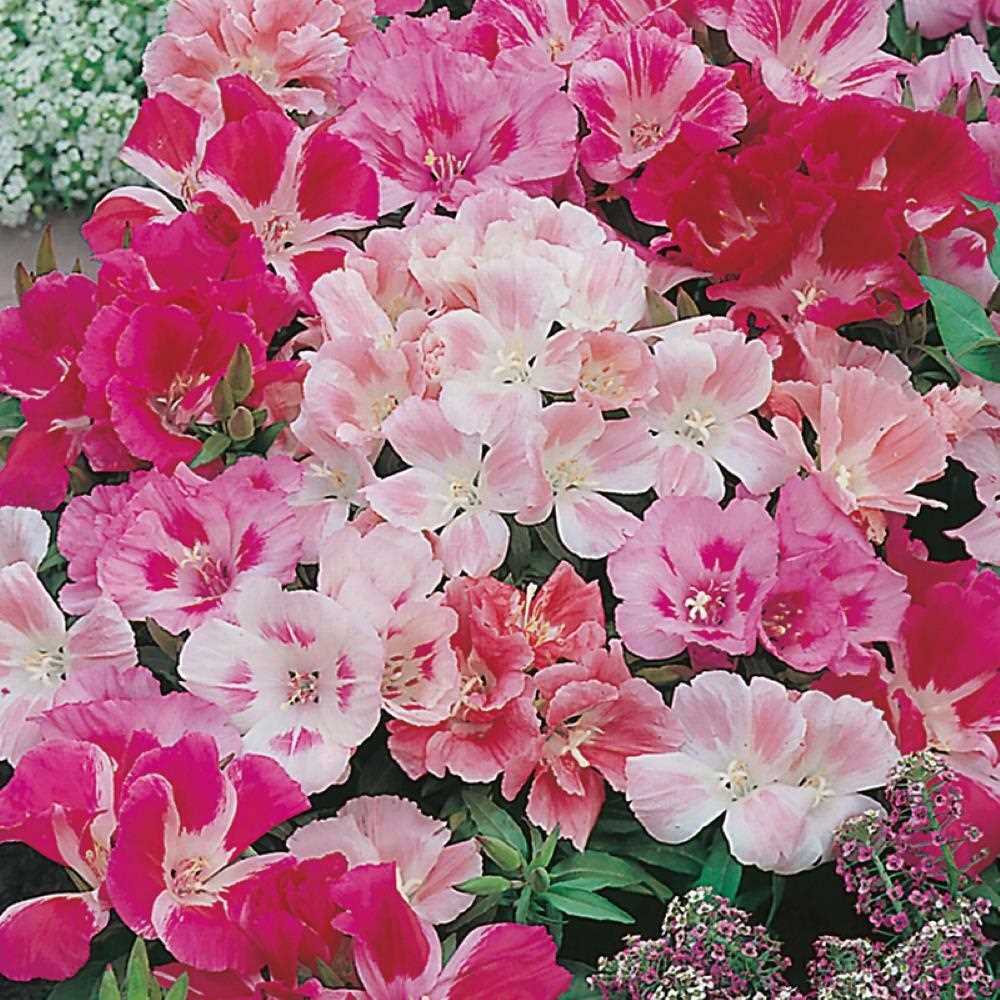
When you grow godetia from seeds, you have access to a wide variety of options. There are numerous godetia seed varieties available, including different colors, sizes, and bloom times. This allows you to choose the perfect godetia plant for your specific garden design and color scheme.
3. Control over the growing process
When you start from seeds, you have complete control over the growing process of your godetia plants. You can ensure that the seeds are planted in the ideal conditions, such as the right soil type and sunlight requirements. This allows you to optimize the growth and overall health of your godetia plants.
4. Satisfaction of nurturing plants from the beginning
Starting godetia plants from seeds can provide a great sense of satisfaction and accomplishment. You get to witness the entire life cycle of the plants, from tiny seeds to beautiful blossoms. It can be an incredibly rewarding experience to nurture and care for your godetia plants from their early stages.
5. Potential for seed saving
When you grow godetia from seeds, you have the potential to save the seeds from your mature plants. This allows you to save money in the long run by collecting and storing the seeds for future plantings. Additionally, it gives you the opportunity to continue growing the same variety of godetia that you have come to love.
Overall, growing godetia from seeds offers numerous benefits, from cost-effectiveness to the satisfaction of nurturing plants from the beginning. Consider starting your godetia plants from seeds to enjoy these advantages and create a beautiful garden filled with colorful blooms.
Types of Godetia
Godetia, also known as farewell-to-spring, is a flowering plant that belongs to the Onagraceae family. There are several types and varieties of Godetia, each with its own unique characteristics and features. Here are some of the most popular types:
1. Godetia grandiflora
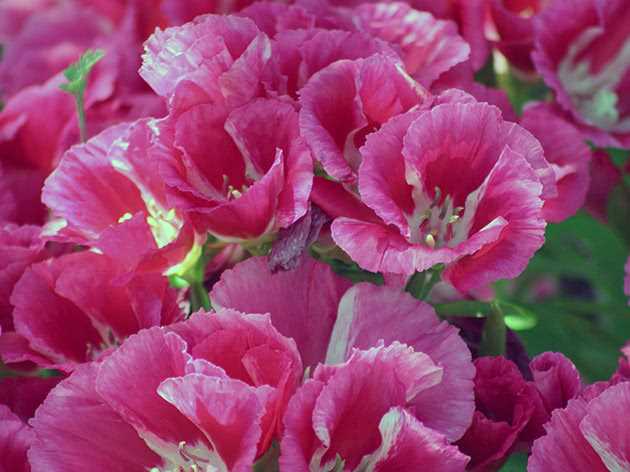
This type of Godetia is known for its large, showy flowers that come in a range of colors including pink, purple, white, and red. The flowers have a delicate texture and a cup-like shape, making them a popular choice for cut flower arrangements.
2. Godetia amoena
Godetia amoena is a smaller variety of Godetia that features flowers in shades of pink, purple, and white. The flowers have a simple, yet elegant, four-petal structure. This type of Godetia is often used as a bedding plant or for container gardening.
3. Godetia bottae
Godetia bottae, also known as satin flower, is a dwarf variety of Godetia that produces small, satin-like flowers in shades of pink, purple, and white. The flowers have a fringed appearance and are highly fragrant, making them a favorite among gardeners.
4. Godetia pinifolia
This type of Godetia is characterized by its needle-like, pine-like leaves, which give it its name. The flowers of Godetia pinifolia are small and come in a range of colors, including pink, purple, red, and white. This variety is often used in rock gardens and border plantings.
5. Godetia quadrivulnera
Godetia quadrivulnera is a unique type of Godetia that features flowers with four petals, arranged in a symmetrical pattern. The flowers come in a variety of colors, including pink, purple, red, and white. This variety is often used in mixed flower beds or as a focal point in the garden.
6. Godetia johannessenii
Godetia johannessenii is a tall variety of Godetia that can reach heights of up to 3 feet. It features large, showy flowers in shades of pink, purple, and white. This variety is often planted in the back of flower beds or used as a border plant.
7. Godetia rothrockii
Godetia rothrockii is a wild variety of Godetia that is native to California. It features delicate, pale pink flowers with a yellow center. This variety is often found growing in meadows and along roadsides.
| Type | Features | Main Uses |
|---|---|---|
| Godetia grandiflora | Large, showy flowers in a range of colors | Cut flowers, garden beds |
| Godetia amoena | Small, simple flowers in shades of pink and purple | Bedding plants, container gardening |
| Godetia bottae | Fragrant, fringed flowers in shades of pink and purple | Container gardening, borders |
| Godetia pinifolia | Needle-like leaves, small flowers in various colors | Rock gardens, borders |
| Godetia quadrivulnera | Symmetrical flowers with four petals in assorted colors | Mixed flower beds, focal points |
| Godetia johannessenii | Tall with large showy flowers in shades of pink and purple | Back of flower beds, borders |
| Godetia rothrockii | Wild variety with pale pink flowers and yellow centers | Meadows, roadsides |
These are just a few examples of the many types and varieties of Godetia available. Each type offers its own unique beauty and charm, making Godetia a popular choice among gardeners and flower enthusiasts.
Single Godetia
Single Godetia is a type of Godetia flower that is characterized by having single petals. The petals are large and showy, with a delicate appearance. Single Godetia flowers come in various colors, including shades of pink, purple, white, and red.
Characteristics of Single Godetia
- Single petals: Single Godetia flowers have only one layer of petals, which gives them their unique appearance.
- Large and showy: The petals of Single Godetia are relatively large and showy, making them an attractive addition to any garden or floral arrangement.
- Delicate appearance: Despite their size, Single Godetia flowers have a delicate and graceful appearance, adding elegance to any landscape.
Growing Single Godetia from Seeds
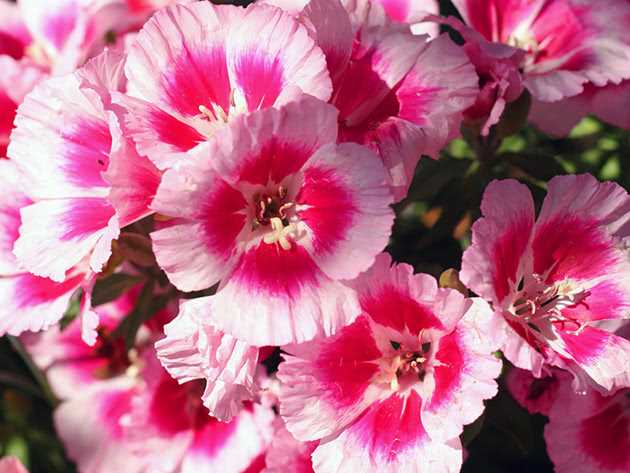
Single Godetia can be easily grown from seeds. Here are the basic steps to follow:
- Prepare the soil: Choose a well-draining soil and remove any weeds or debris from the planting area.
- Sow the seeds: Scatter the Single Godetia seeds over the soil, ensuring that they are evenly distributed.
- Lightly cover the seeds: Gently press the seeds into the soil, but do not bury them too deep.
- Water thoroughly: Water the seeds immediately after sowing, and keep the soil consistently moist throughout the germination period.
- Thin the seedlings: Once the seedlings emerge, thin them out so that they are spaced about 8-12 inches apart.
- Provide proper care: Single Godetia prefers full sun to light shade and requires regular watering and fertilization to thrive.
Popular Varieties of Single Godetia
There are several popular varieties of Single Godetia to choose from. Here are a few examples:
| Variety | Description |
|---|---|
| Crown Single | A compact variety with large, fringed petals in vibrant colors. |
| Satin Slippers | A taller variety with ruffled petals in shades of pink, purple, and white. |
| Dazzler | A dwarf variety that produces an abundance of single blooms in various colors. |
These are just a few examples of the many beautiful varieties of Single Godetia available. With their stunning appearance and easy cultivation, Single Godetia is a popular choice for gardeners and flower enthusiasts alike.
Double Godetia
Double godetia is a variety of the godetia flower that features double layers of petals, giving it a fuller and more voluminous appearance. This variety is known for its beautiful and intricate blooms, making it a popular choice among gardeners and flower enthusiasts.
Here are some key features of double godetia:
- Petals: Double godetia flowers have multiple layers of petals, often arranged in a ruffled or fringed pattern. This gives them a unique and eye-catching look.
- Colors: Double godetia comes in a wide range of colors, including pink, white, purple, and red. This makes it a versatile choice for adding vibrant and attractive hues to your garden.
- Size: The size of double godetia flowers can vary, but they are generally medium-sized blooms. They can reach a diameter of about 2 to 4 inches (5 to 10 cm).
- Growth habit: Double godetia plants are typically bushy and compact, with a height ranging from 12 to 24 inches (30 to 60 cm). They have multiple stems and produce abundant flowers.
- Blooming period: Double godetia blooms during the summer months, typically from June to August. With proper care, the plants can continue to produce flowers for an extended period.
Double godetia is a relatively easy plant to grow from seeds. It thrives in well-draining soil and prefers full sun or partial shade. The seeds can be sown directly into the garden soil after the danger of frost has passed, or they can be started indoors in seed trays and transplanted later.
When growing double godetia, it is important to provide adequate water and fertilization. Regular deadheading of faded flowers can also promote continuous blooming. These plants are relatively low-maintenance but benefit from occasional pruning to maintain their shape and remove any dead or diseased parts.
Double godetia can be a stunning addition to any garden or flower bed. Its unique double petals and vibrant colors make it a standout choice for those looking to add interest and beauty to their outdoor spaces.
Varieties of Godetia
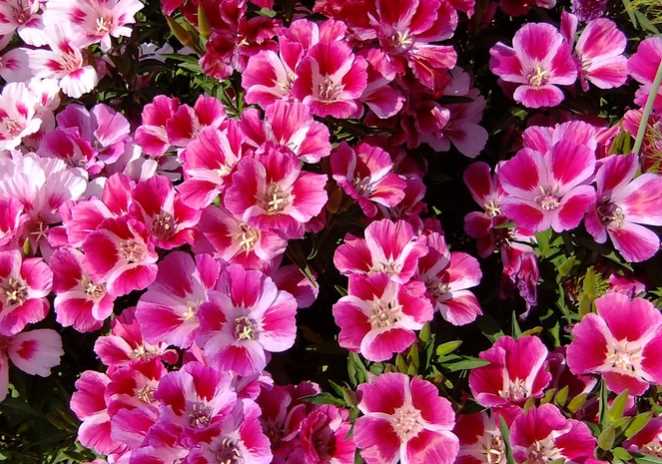
Godetia, also known as farewell-to-spring or Clarkia, is a beautiful flowering plant that brings vibrant colors to any garden. There are several varieties of godetia to choose from, each with its own unique characteristics. Here are some popular varieties:
1. Godetia grandiflora
This variety is known for its large and showy flowers, which come in various shades of pink, purple, and white. The flowers have a delicate, cup-shaped appearance and stand out against the plant’s bright green foliage. Godetia grandiflora is a popular choice for borders and containers.
2. Godetia amoena
Godetia amoena, also called satin flower, is another popular variety known for its rich and velvety single or double flowers. The flowers of Godetia amoena range in color from white and pink to deep red and burgundy. This variety grows in dense clusters and is often used in cut flower arrangements.
3. Godetia picta
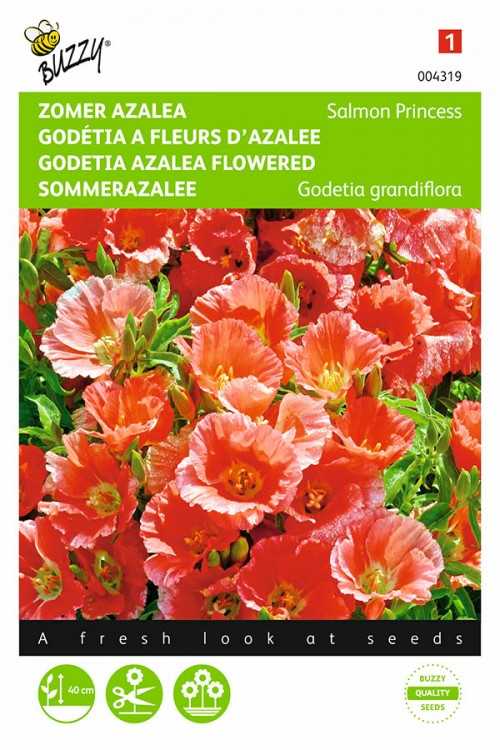
Godetia picta is a compact variety that produces an abundance of petite flowers in shades of pink, salmon, and lavender. This variety is perfect for planting in containers or along the edges of flower beds. It is a low-growing plant that creates a beautiful carpet of color.
4. Godetia quadrivulnera
Godetia quadrivulnera is a variety with unique four-petaled flowers. The flowers can be found in shades of pink, purple, and white and have a slightly ruffled appearance. This variety is easy to grow and adds a touch of charm to any garden or landscape.
5. Godetia bottae
Godetia bottae is a rare variety that is native to California. It features bright pink flowers with dark markings at the center. Godetia bottae is a tall variety that can reach up to 4 feet in height. It is a great choice for adding height and color to the back of flower borders.
6. Godetia amabilis
Godetia amabilis is a delicate variety that produces small, bell-shaped flowers in shades of pink and white. The flowers have a lovely fragrance and attract butterflies and bees. Godetia amabilis is a good choice for rock gardens or as a ground cover.
These are just a few of the many varieties of godetia available. Whether you are looking for large and showy flowers or small and delicate blooms, there is a godetia variety for you. Experiment with different varieties to create a stunning display of color in your garden.
Grace Godetia
Grace Godetia is a popular variety of the Godetia flower. It is known for its striking beauty and delicate appearance. This variety is widely grown for its attractive pink, purple, and white flowers that bloom in late spring and summer.
Characteristics
- Height: Grace Godetia typically grows to a height of 12-18 inches.
- Flower Size: The flowers of Grace Godetia are medium-sized, ranging from 1-2 inches in diameter.
- Colour: The flowers can be found in various shades of pink, purple, and white.
- Blooming Season: Grace Godetia blooms from late spring to summer.
Growing Grace Godetia
Here are some tips for successfully growing Grace Godetia:
- Planting: Sow the seeds of Grace Godetia directly into the garden bed in early spring, after the danger of frost has passed. Choose a location with well-drained soil and full sun exposure.
- Soil Preparation: Before planting, prepare the soil by removing weeds and adding organic matter, such as compost, to improve its fertility and drainage.
- Seed Spacing: Space the seeds of Grace Godetia about 6-8 inches apart to allow enough room for the plants to grow and spread.
- Watering: Keep the soil consistently moist, but not waterlogged, throughout the growing season. Avoid overwatering, as it can cause root rot.
- Fertilization: Feed Grace Godetia plants with a balanced fertilizer once a month to promote healthy growth and abundant flowering.
- Deadheading: Remove faded flowers regularly to encourage continuous blooming.
- Pest and Disease Control: Watch out for common pests, such as aphids and slugs, and treat them as soon as they appear. Provide proper air circulation to prevent diseases like powdery mildew.
Uses
Grace Godetia is often used in flower arrangements and bouquets due to its vibrant colors and attractive appearance. It can also be grown in containers and borders to add a touch of elegance to the garden.
Conclusion
Grace Godetia is a stunning variety of the Godetia flower that is easy to grow and brings a touch of grace and beauty to any garden. With its attractive colors and delicate blooms, it is sure to be a showstopper in any floral display.
Satin Godetia
Satin Godetia is a popular variety of the Godetia flower, known for its beautiful satin-like petals. It is often grown as an annual in flower beds and borders.
Characteristics
- Satin Godetia plants typically grow to a height of 12 to 18 inches.
- They produce large, showy flowers with ruffled petals that have a satin or silky texture.
- The flowers come in a range of colors, including shades of pink, white, and purple.
- The foliage of Satin Godetia is slender and lance-shaped, providing an attractive green backdrop to the flowers.
Growing Satin Godetia
Satin Godetia can be easily grown from seeds. Here are the steps to grow them:
- Prepare a well-draining soil bed, enriched with organic matter.
- Sow the satin godetia seeds in early spring, after the threat of frost has passed.
- Scatter the seeds on the soil surface and lightly press them into the soil.
- Water the seeds gently to ensure the soil is evenly moist.
- Place a layer of mulch over the seeds to help retain moisture and suppress weed growth.
- Keep the soil consistently moist but not soggy as the seeds germinate and the plants grow.
- Thin out the seedlings once they are a few inches tall, spacing them about 6 inches apart.
- Continue to water and care for the plants as they grow, providing regular fertilization during the growing season.
Uses
Due to its attractive flowers and foliage, Satin Godetia is often used in garden borders, flower beds, and containers. It can also be used as a cut flower for arrangements and bouquets, adding a touch of elegance.
Conclusion
Satin Godetia is a beautiful variety of Godetia that adds a touch of elegance to any garden or floral arrangement. With its satin-like petals and vibrant colors, it is sure to be a focal point. By following the steps outlined above, you can easily grow your own Satin Godetia and enjoy its beauty throughout the growing season.
Dwarf Godetia
Dwarf Godetia is a popular variety of the Godetia flower, known for its compact size and vibrant colors. It is a charming addition to any garden or container, and it is relatively easy to grow from seeds.
Characteristics
- Dwarf Godetia is a low-growing plant, reaching a height of only 6 to 12 inches.
- It has a bushy habit and forms a dense clump of foliage.
- The flowers of Dwarf Godetia are trumpet-shaped and come in a variety of colors, including pink, white, purple, and red.
- The blooms have a delicate texture and are about 2 to 3 inches in diameter.
- Dwarf Godetia flowers attract butterflies and other pollinators to the garden.
Growing from Seeds
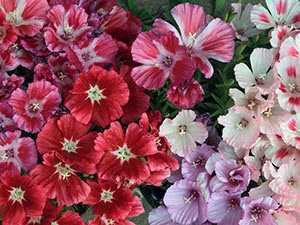
Here are the steps to grow Dwarf Godetia from seeds:
- Sow the seeds indoors 6 to 8 weeks before the last frost date or directly in the garden after the danger of frost has passed.
- Choose a location with full sun or light shade for planting.
- Prepare the soil by loosening it with a garden fork and mixing in some compost or well-rotted manure.
- Scatter the seeds on the soil surface and lightly press them into the soil, ensuring that they are covered with a thin layer of soil.
- Water the seeds gently to keep the soil moist but not waterlogged.
- Germination usually takes about 2 weeks.
- Thin the seedlings to a spacing of 6 to 8 inches apart once they have a couple of true leaves.
- Continue to water the plants regularly, keeping the soil evenly moist.
- Apply a balanced fertilizer every 4 to 6 weeks to promote healthy growth and abundant blooms.
- Dwarf Godetia plants typically start blooming in early summer and continue until the first frost.
Uses
Dwarf Godetia is a versatile flower that can be used in various ways:
- It makes an excellent addition to flower beds and borders, adding color and interest to the landscape.
- Dwarf Godetia is well-suited for container gardening, such as hanging baskets or window boxes.
- The flowers can be cut and used in floral arrangements.
- They also make great companions to other sun-loving annuals and perennials in mixed plantings.
| Common Name | Dwarf Godetia |
|---|---|
| Scientific Name | Clarkia amoena |
| Plant Type | Annual |
| Height | 6 to 12 inches |
| Exposure | Full sun to light shade |
| Bloom Time | Early summer to first frost |
| Colors | Pink, white, purple, red |
Tall Godetia
Tall godetia, also known as Clarkia amoena, is a popular annual flower that adds height and color to garden beds and borders.
Growth and Characteristics
- Tall godetia plants can grow to a height of 2 to 3 feet.
- They have slender, erect stems and lance-shaped leaves.
- The flowers of tall godetia are larger compared to other varieties and have a cup-shaped structure.
- The blooms can come in various shades of pink, red, white, and purple.
- Tall godetia plants attract pollinators, such as bees and butterflies, making them great for supporting local ecosystems.
Planting and Care
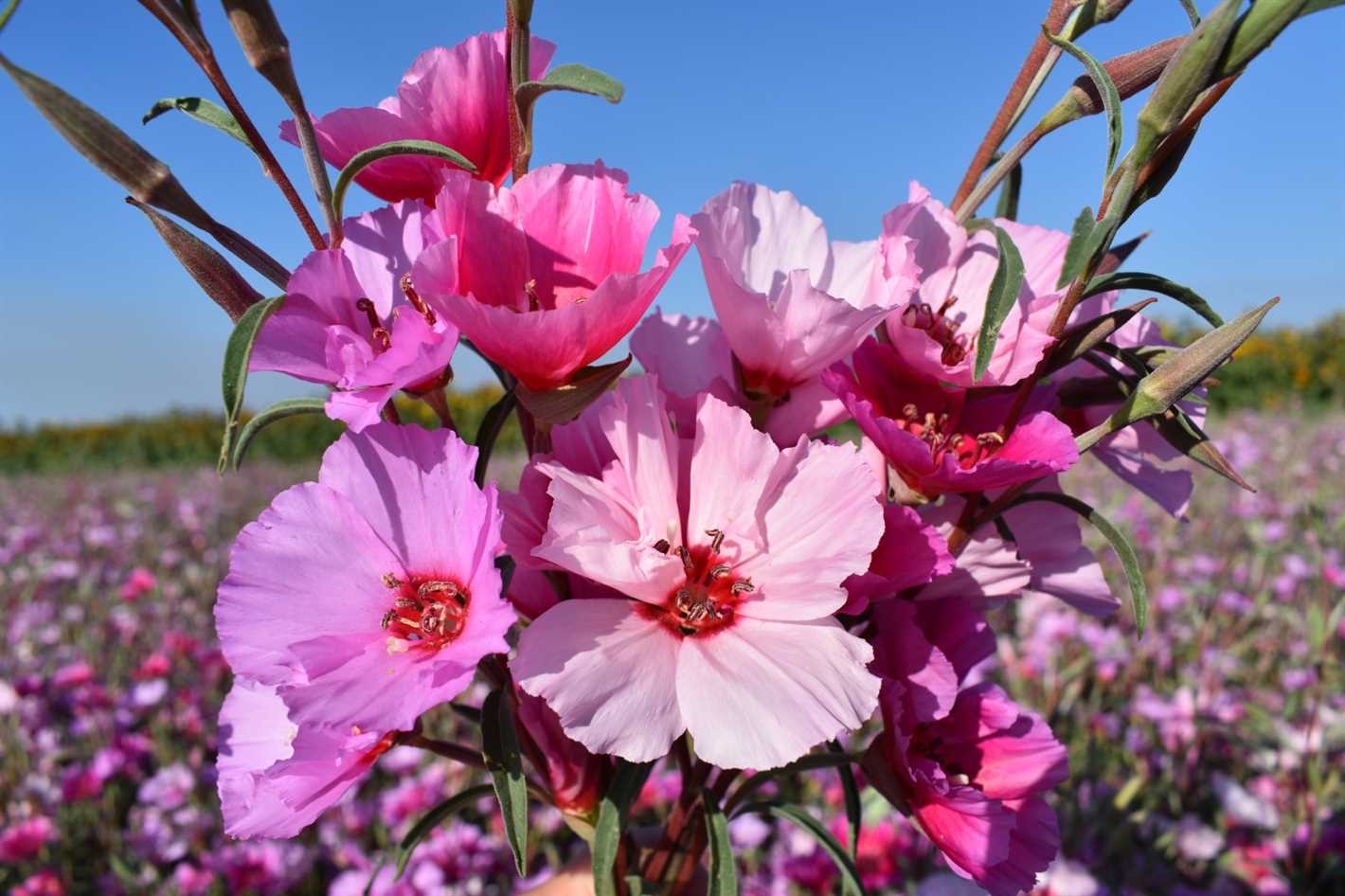
Tall godetia can be grown from seeds. Here are some tips for successful cultivation:
- Sow the seeds directly into a well-prepared garden bed or container. Choose a location that receives full sun to partial shade.
- Plant the seeds in early spring, after the last frost date in your area.
- Prepare the soil by loosening it and removing any weeds or debris.
- Scatter the seeds on the soil surface and lightly press them down. Cover the seeds with a thin layer of soil or compost.
- Water the area gently to ensure proper moisture for germination.
- Keep the soil consistently moist but not waterlogged throughout the growing season.
- Thin the seedlings once they are a few inches tall, allowing 6 to 12 inches of space between each plant.
- Apply a balanced fertilizer once a month to promote healthy growth.
- Remove spent flowers to encourage continuous blooming.
Uses
Tall godetia can be used in various ways:
- They make excellent cut flowers for floral arrangements.
- Tall godetia plants can be grown in containers or hanging baskets to add vertical interest to a garden display.
- They are suitable for cottage gardens, borders, and meadow-like plantings.
- Tall godetia can also be mixed with other annuals or perennials for a burst of color in flowerbeds.
Conclusion
Tall godetia is a beautiful and versatile annual flower that can enhance any garden. With its tall stature and vibrant blooms, it adds a splash of color and attracts beneficial pollinators. By following the planting and care instructions, you can enjoy a lovely display of tall godetia in your own garden.
Questions and Answers:
What is godetia?
Godetia is a flowering plant that belongs to the Onagraceae family. It is native to North America and is known for its beautiful, cup-shaped flowers.
How do I grow godetia from seeds?
To grow godetia from seeds, you need to start by preparing the soil. Godetia prefers well-drained soil that is enriched with organic matter. Sow the seeds in the spring or fall, about 6 to 8 weeks before the last frost date. Keep the soil moist but not waterlogged, and provide the plants with plenty of sunlight. The seeds should germinate within 1 to 2 weeks.
What are the different types of godetia?
There are several types of godetia, including grandiflora godetia, dwarf godetia, and semi-double godetia. Grandiflora godetia has large, showy flowers, while dwarf godetia is shorter and more compact. Semi-double godetia has flowers with double petals.
Can I grow godetia in containers?
Yes, godetia can be grown in containers. Choose a container that is at least 6 inches deep and has drainage holes in the bottom. Fill the container with well-drained potting soil and sow the godetia seeds according to the instructions. Place the container in a sunny location and water regularly. Remember to fertilize the plants every few weeks to promote healthy growth.
How long does it take for godetia to bloom?
Godetia usually blooms within 8 to 12 weeks after sowing the seeds. However, the exact blooming time can vary depending on the variety and growing conditions.
Where can I buy godetia seeds?
Godetia seeds can be purchased from various sources, including garden centers, online seed stores, and catalogs. You can also consider saving the seeds from your existing godetia plants for future use.







